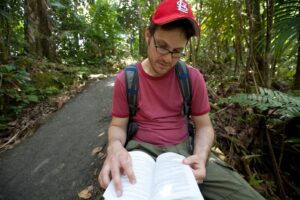By: Abby Bezrutczyk
While many forest ecologists have their eyes on the trees, Dr. Jason Fridley turns to the shrubs– asking how special adaptations can make some infamous invaders. NYISRI is pleased to highlight his invasive shrub research for this month’s spotlight:

What kinds of research questions related to invasive species are you currently asking?
In my lab at Syracuse we study how plants work, including adaptations that allow species to tolerate conditions where resources required for growth and reproduction—light, water, and nutrients—are in short supply, as is the case in mature forests. Invasive plants are often considered those that grow fast when resources are abundant (i.e., ‘weeds’), but one of the largest environmental challenges in the Eastern U.S. is the increasing dominance of non-native shrubs and vines that are remarkably shade tolerant. We study the underlying biology of these invaders, and ask what is so different about them that allows them to thrive in our forests, even in competition with native shrubs and trees. Of particular interest is how they coordinate growth in leaves and roots, because living in shade requires heavy investment in soil nutrient foraging to build leaf proteins, often with the help of soil fungi and bacteria.
What are the basic methods you are using to answer your research questions?
We use many of the tools common in plant physiological research, such as machines that determine elemental concentrations in plant tissues (like nitrogen and carbon), and those that measure how fast plants ‘breathe’ (respiration) and make food (photosynthesis). Sometimes we measure plants in nature, and sometimes we run field or greenhouse experiments. For example, a recent pot experiment by a PhD student exposed native and invasive plant species to different types of soil fungi to determine which was more dependent on them (it turns out that natives are, which one might expect given the fungi are also presumed to be native).
Do you have a personal story or path that led to your interest in this research?
I’ve worked on other issues in the field of plant ecology, but for some reason it’s our research on invasive species that has had the most impact. When I started graduate school I had little knowledge of biological invasions, but a friend piqued my interest and got me thinking about forest invaders (specifically, autumn olive [Elaeagnus umbellata], which was increasingly abundant in suburban forests but with almost no research activity). It was this research vacuum that motivated my entry into this research, and I’ve been fascinated by shrub biology since. It helps that most researchers in forest ecology are distracted by trees.
How does your research relate to the wider field of invasive species prevention/management?
I struggle a lot with this question, because so much good work is being done on the front lines of invasive species research that has immediate impact on control (e.g., pest introduction for biocontrol) and prevention (e.g., risk assessments). Our work by comparison may help us understand the ‘why’ of forest invasions but not necessarily the ‘how’ of management. However, recently we’ve made some discoveries in the biology of invasive shrubs and vines that may make a difference, particularly in risk assessment. It turns out that there is a relatively easy way to distinguish the behaviors of native and invasive forest shrubs, using just a few attributes that are easy to measure in a garden environment. These attributes may allow widespread ‘screening’ of new introductions to indicate which may become future invaders. This is especially important given there are hundreds of potential new invaders out there.
What’s the most important thing about your research for managers and policy makers to know?
Although not specific to my research, I’d like policy makers to better understand the true implications of the spread of invasive species in our forests. There is a hidden cost associated with invasions that amounts to a gradual erosion of our enjoyment and understanding of nature. What I mean by this is that the public’s support of environmental issues often derives from special experiences they’ve had in natural places (say, hiking the Adirondacks, or camping in Maine), and those experiences are driven in part by the diversity they see. Particularly in the East where the beauty of a landscape is often in its plants rather than its landforms, a hiking experience dominated by a handful of invaders along the trail—say Oriental bittersweet in Acadia National Park—doesn’t foster the feeling of natural wonder that one gets by seeing one habitat transition to another through its native diversity.
What do you hope the long-term impact of your work will be?
It would of course be ideal if our work eventually helped to reduce the spread of non-native species, but I’ll be satisfied if our research contributes significantly to our understanding of how plants work, how ecosystems assemble, or how plant communities impact ecosystem functioning. For example, much of what plants do belowground remains a mystery, and I’d love to eventually understand the coordination of plant behaviors above- and belowground. It’s possible—in fact much current research suggests—that root behaviors are diverse and only weakly related to leaf function. But it may also be that studies have examined too few species, or too few behaviors, to find the important root-shoot linkages. Ideally our research will help resolve this puzzle, but much remains to be done.

